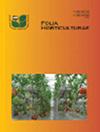The effects of organic and conventional fertilization on oregano (Origanum onites L.) yield and quality factors
IF 1.8
4区 农林科学
Q2 HORTICULTURE
引用次数: 0
Abstract
ABSTRACT Oregano (Origanum onites L.) is an important medicinal and aromatic plant. The use of sector and economic value of oregano are determined by quality in world trade. This study was conducted during 2019–2021 to determine the effects of chemical and organic fertilizers on yield and quality of O. onites L. The experiment followed a randomized complete block design with six treatments and four replications, i.e., control (C: untreated plants), chemical fertilizer (F) (150:90:100 kg · ha−1), farmyard manure (FYM), chicken manure (CM), vermicompost (VC) and spent mushroom compost (SMC) (the objective was to obtain 150 kg N · ha−1 for organic fertilizer). Fresh yield increased by 3.36%–11.44% and 5.61%–13.59% with organic fertilization as compared with the control in both years while it increased by 22% and 19.0% with chemical fertilization. FYM and SMC were more effective in fresh yield among organic fertilizers. Essential oil (EO) increased by 18.8%–50.1% and 2.94%–19.85% with fertilization as compared with the control in both years. EO yield was significantly increased by fertilization, and CM was in the lead with direct effect, while VC and FYM had residual effects. The applications increased the carvacrol and thymol content of the EO compared with the control. VC was the most effective application for total flavonoid content, antioxidant activity and plant nutritional status, especially for nitrogen, phosphorus, potassium and calcium concentrations. The results showed that chemical and organic fertilizers positively affected the yield, EO content and nutritional status of O. onites.有机施肥和常规施肥对牛至产量和品质因素的影响
牛至是一种重要的药用芳香植物。牛至的行业用途和经济价值取决于世界贸易中的质量。本研究于2019-2021年进行,旨在确定化学肥料和有机肥料对O.onites L.产量和质量的影响。实验采用随机完全区组设计,共有六个处理和四个重复,即对照(C:未处理的植物)、化学肥料(F)(150:90:100 kg·ha−1)、农家肥(FYM)、鸡粪(CM),蚯蚓堆肥(VC)和废蘑菇堆肥(SMC)(目的是获得150 kg N·ha−1的有机肥料)。有机肥和化学施肥分别比对照增产3.36%~11.44%和5.61%~13.59%,化学施肥分别增产22%和19.0%。在有机肥料中,FYM和SMC对鲜产量的影响较大。与对照组相比,施肥前后精油含量分别增加18.8%-50.1%和2.94%-19.85%。施肥显著提高了EO产量,CM在其中起主导作用,VC和FYM有残留作用。与对照组相比,应用增加了EO中香芹酚和百里酚的含量。VC对总黄酮含量、抗氧化活性和植物营养状况最有效,尤其是对氮、磷、钾和钙浓度最有效。结果表明,化学肥料和有机肥料对燕麦产量、EO含量和营养状况均有积极影响。
本文章由计算机程序翻译,如有差异,请以英文原文为准。
求助全文
约1分钟内获得全文
求助全文
来源期刊

Folia Horticulturae
Agricultural and Biological Sciences-Horticulture
CiteScore
3.40
自引率
0.00%
发文量
13
审稿时长
16 weeks
期刊介绍:
Folia Horticulturae is an international, scientific journal published in English. It covers a broad research spectrum of aspects related to horticultural science that are of interest to a wide scientific community and have an impact on progress in both basic and applied research carried out with the use of horticultural crops and their products. The journal’s aim is to disseminate recent findings and serve as a forum for presenting views as well as for discussing important problems and prospects of modern horticulture, particularly in relation to sustainable production of high yield and quality of horticultural products, including their impact on human health.
 求助内容:
求助内容: 应助结果提醒方式:
应助结果提醒方式:


